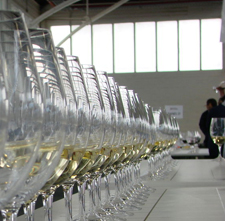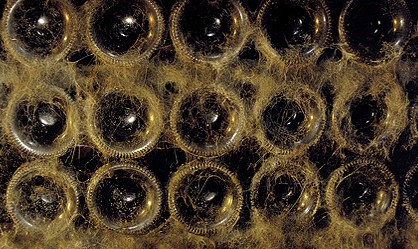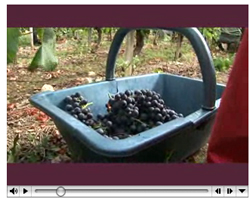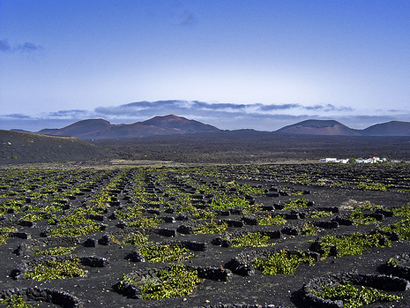Dr Vino's wine blog
wine talk that goes down easy
Perceiving chaptalization in the glass: is it possible? [wonky]
 Here’s a question for all the (Northern European) wine geeks out there: Can you tell if a wine has been chaptalized based solely on the smell and taste?
Here’s a question for all the (Northern European) wine geeks out there: Can you tell if a wine has been chaptalized based solely on the smell and taste?
Chaptalization is the term for adding sugar to wine to boost the alcohol level. It is legally permissible in parts of the wine world, particularly northern Europe. Some producers still use the practice, although global warming may be creating more ripe fruit, thus obviating the need. (In other parts of the world, notably where it is hotter, it is prohibited; indeed, it may be permissible to add acid.) Alternately known as enrichment or amelioration, the process occurs before or during fermentation. Although sucrose is usually the addition of choice, from either beet sugar or cane sugar, producers can add grape concentrate or even “rectified concentrated grape must.” Fermentation ensures no residual sugar is left behind since the sugars are converted into alcohol (and CO2).
An anonymous poster recently left a comment on this site claiming lab test showed a wine had been chaptalized (legally permissible) but failed to follow up with the lab report. He or she also suggested that a tasting of the white wine revealed notes of chaptalization, such as caramel and bonbon. Really? What do you think, is it possible to perceive chaptalization in the glass? If so, which sort of descriptors would you apply?
Traditionalists vs modernists: a battle royale?

The current copy of The World of Fine Wine just landed on my desk with a thud. Since it’s based in London and costs $169 a year, it’s not something you can readily pick up at Hudson News. In this issue, the 216-page glossy magazine/journal compiles provocative essays and tasting reports from independent journalists and some people in the trade.
One essay that caught my eye was about the stylistic struggle between modernists and traditionalists that has been roiling the wine world for some time now. (For those who haven’t been following, “modern” wines are often characterized as having abundant, ripe fruit, lots of extraction, quite a bit of oak influence, and higher in alcohol while “traditional” wines are construed as being less overtly oaky, having much less extraction and manipulation in the cellar.)
In the piece, Mike Steinberger argues that the polarization has been overplayed–too bad since it could really do well in a Broadway adaptation, perhaps besting the Sharks vs Jets! Further, there’s a vast gray area between these two poles. Finally, he argues that the rise of modern wines has actually been largely beneficial by getting the traditionalists to clean up their cellars and pay more attention to their vineyards. Here’s a snippet:
It is wrong to depict this modern-versus-traditional split as a kind of Manichean, zero-sum battle. It is something far more mild: a push here, some push-back there. Not only that; it has largely redounded to the benefit of both wine and wine consumers.
As to the state of play in the non-war, he argues, the pendulum is swinging back to the traditionalists. As evidence, he cites, on the one hand, general fatigue with Super Tuscans and garage wines of Bordeaux. On the other, he notes the tremendous regard for traditional Piedmont producers such as Giacosa, G. Conterno, and G. Moscarello, a tsunami of articles about Lopez de Heredia in Rioja (I’ll add that the crowds are always deep at their annual distributor tasting in NYC), and a “greater demand for authenticity–for wines that are made by people who actually get their hands dirty in the vineyard.” Check out the whole article in print if you get a chance.
What do you think? I find it a convincing argument while also admitting the evidence is still contained to something of a niche. But with all the interest in natural wines, making wine in amphorae, resurrecting heirloom varieties, and a greater respect for the vineyard more generally, that niche could expand noticeably over the coming decade. Moreover, the amount of column inches (remember those?), blog posts and tweets in favor of traditionally styled wines must sooner or later spark some demand, thus leaving some modern producers wondering if they might want to cancel their next order for new oak barrels and experiment with something a little more olde tyme.
UPDATE: the article is now available online at The World of Fine Wine website. Also, they are extending a 20% discount to the readers of this site; enter WFW5 into the subscription form (DrVino.com receives no compensation).
cropped image from lopezdeheredia.com
From the annals of wine marketing…enzymes!
 We’re all snow-bound here in the northeast today. So rather than shoveling, kick back and check out the latest video from the annals of wine marketing! This one is from enzymes producer Novozymes and was sent in by site reader Damien.
We’re all snow-bound here in the northeast today. So rather than shoveling, kick back and check out the latest video from the annals of wine marketing! This one is from enzymes producer Novozymes and was sent in by site reader Damien.
Here’s the video’s pitch on why winemakers should use enzymes:
Major wineries produce large quantities of wine and as a result need to optimize their capacity by reducing production times. [image: hand harvesting] Enzymes are used by these larger wineries to speed up production process. Small wineries on the other hand are more interested in using enzymes to produce a higher quality of wine, particularly when the grape quality isn’t the best.
Other quotage comes form their enthusiastic client, Ch. Tour Prignac, who says that they use it “to produce optimum quality and obtain a color fitting to a great, age-worthy wine.”
They later elaborate that their products, under the VinoFlo name, offer deep colors and flavor intensity.
Waiter, there’s a snow globe in my wine! [tartaric crystals]
What’s happening in this glass? The winemaker practices minimal intervention and uses no sulfur. So one theory is refermentation, which can come from excessive heat exposure. Or it could be a tsunami of tartaric crystals, which can be caused excessive by cold exposure. What do you think? And more importantly, would you drink this wine?
If they are tartaric crystals, consider this from the Oxford Companion to Wine: “Only the most informed consumers appreciate the harmlessness of tartrate crystals in bottle. Although tartrates precipitated in red wines usually take on some red or brown pigments and are commonly regarded as mere sediment, in white wines they look alarmingly like shards of glass to the uninitiated. The modern wine industry has in the main decided that tartrate stabilization is preferable to consumer education.” All right, then, we can consider ourselves educated! More on cold stabilization and the “wine diamonds” of tartrates can be found here.
Rocks for shocks: geologists don’t “debunk” terroir; minerality questioned

Many geologists object to two things: misusing “minerality” and being misquoted.
Site reader and distributor Damien Casten sent in an AP story (with no byline) yesterday entitled “Geologists debunk soil impact on wine at Ore. talk.” The Oregon event was a special session at the annual conference of the Geological Society of America.
At the meeting, Alex Maltman presented a paper with this to say about minerality: “The widely cited direct, literal connection between vineyard geology and wine taste seems scientifically impossible. Whatever “minerality†in wine is, it is not the taste of vineyard minerals.” He calls any perceived connection a “romantic myth.”
Fair enough, there may not be a transfer of minerals from substrate to the glass, but is terroir debunked? Not quite, argued Jonathan Swinchatt in a paper that cites the indirect influences of drainage, accessibility to water, microbiology, soil temperature, and trace element chemistry. He argued that unraveling these links is “devilishly” complex and thus “the connections between geology and wine will remain elusive for some time to come.”
Terroir: clear as mud!
After the jump, Greg Jones, a climatologist from Southern Oregon University (and son of the founder of Abacela Vineyards and Winery in Roseburg, OR) chimes in with his thoughts from the conference and the reporting of it. Read more…
Screwcaps, scores, riesling, the Loire, Cali cab: John Gilman part two
 We’re back with Part Deux of our interview with John Gilman, author of the newsletter A View from the Cellar (part one is here). John has offered a free issue from his backlist to any Dr. Vino reader so surf on over to his site and check it out. In this part of the Q&A, I had intended John to give a quick thumbs up or thumbs down on a number of hot-button issues in the wine world today as well as some things that I’ve heard him express unusual views about. In case you thought you were done gorging during the holidays, you can now feast on John’s 7,000+ words in this second part. So buckle up and get ready to hear his thoughts on what’s wrong with Riesling from Austria and Australia, screwcaps and their problems, the Loire, California cab then and now, indigenous yeasts, roto-fermenters, small oak barrels, wines over 14% alcohol and why he uses scores!
We’re back with Part Deux of our interview with John Gilman, author of the newsletter A View from the Cellar (part one is here). John has offered a free issue from his backlist to any Dr. Vino reader so surf on over to his site and check it out. In this part of the Q&A, I had intended John to give a quick thumbs up or thumbs down on a number of hot-button issues in the wine world today as well as some things that I’ve heard him express unusual views about. In case you thought you were done gorging during the holidays, you can now feast on John’s 7,000+ words in this second part. So buckle up and get ready to hear his thoughts on what’s wrong with Riesling from Austria and Australia, screwcaps and their problems, the Loire, California cab then and now, indigenous yeasts, roto-fermenters, small oak barrels, wines over 14% alcohol and why he uses scores!
German Riesling
To my mind this is clearly the most singularly misunderstood and underappreciated region for great wines in the world. Read more…
An unknown culture: yeasts
 The next time you hear a wine maker extolling the virtues and distinctiveness of the vineyard, a good follow up question might just be to ask about the yeasts used in fermentation.
The next time you hear a wine maker extolling the virtues and distinctiveness of the vineyard, a good follow up question might just be to ask about the yeasts used in fermentation.
Yeasts may be boring, invisible agents of the fermentation process but they have been getting more attention recently. Jancis Robinson is the latest to focus on them in her column from Saturday’s Financial Times, “Forget the grapes, it’s a cultural thing.” To the tape:
The overwhelming quantity of wine on sale today was fermented using commercially available strains of yeast, yeasts specially chosen for their particular and powerful attributes…One prominent New Zealand winemaker claims…that he can make any required style of Sauvignon Blanc from exactly the same grapes, provided he can choose the yeast. The following thoughts have been inspired by Chardonnays that taste like Sauvignon Blancs, a raft of indistinguishable New World Syrahs, and my sense that the flavour spectrum of wines today seems narrower than it has ever been.
She then describes some of the characteristics. Enoferm Assmannshausen®, for example, suggests that it be used “for making Pinot Noir and Zinfandel. It is considered a color friendly strain that enhances spicy (clove, nutmeg) and fruity flavours and aromas.” Lalvin CY3079® is designed “for barrel fermented Chardonnay and aging on lees. Gives rich, full mouthfeel and aromas” while Uvaferm SVG® is designed “to enhance typical Sauvignon character, diminished acidity and with good fermentation kinetics.”
While methods of grape growing and vineyard sites are certainly important, yeasts deserve to leaven the discussion of winemaking more than they do.
Verbatim: Parker and Nossiter
“[Winemaking] parameters are dictated by an international taste and by champions of this taste – including Robert Parker, The Wine Spectator and certain Spanish critics like José Peñin. They are then produced by taste bureaucrats like Michel Rolland and hundreds of indigenous enologists like Telmo Rodriguez,” says Mondovino-director Jonathan Nossiter in his new book, Le Goût et le Pouvoir (Taste and Power). Link
“I guess everyone is getting frazzled by higher and higher wine prices and WMDs(wines of massive deliciousness)…..but seriously… anyone with half a chimp’s brain can see through Nossiter’s transparency easier than a J.J.Prum riesling…it is Nossiter and his ilk(call them the scary wine gestapo)chanting the same stupid hymn that demand wines be produced in only one narrow style…..but bring on the suckers and fools….some one will certainly buy into his propaganda as they did that migraine-inducing disingenuous film……” eBob
Related: “Mondovino: shaky not stirring” [Dr. V]



